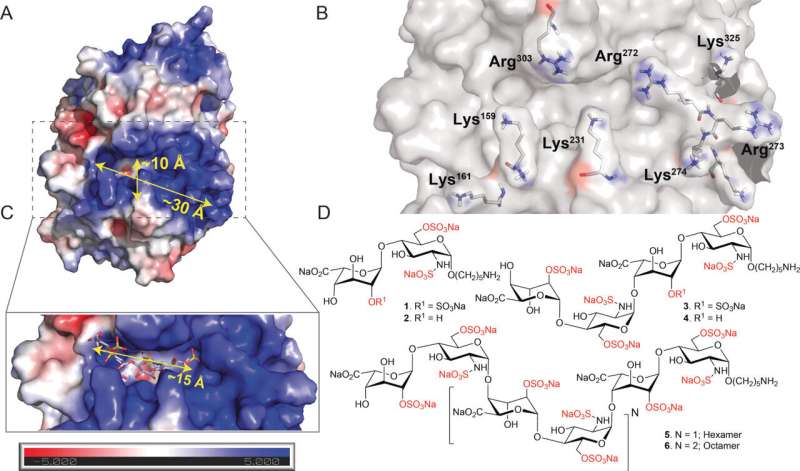This article has been reviewed according to Science X's editorial process and policies. Editors have highlighted the following attributes while ensuring the content's credibility:
fact-checked
peer-reviewed publication
trusted source
proofread
Researchers a step closer to effective heparanase inhibitor

The cellular protein heparanase plays an important role in allowing diseases, including viruses and cancers, to spread within our bodies. For this reason, researchers investigating a wide range of diseases are eager to find an effective heparanase inhibitor.
Scientists from the University of Illinois Chicago, along with colleagues at the University of Georgia and Utrecht University in the Netherlands, found a molecule effective at inhibiting heparanase activity related to the herpes simplex virus and reduced the spread of the virus when tested on human cells. The new research is published in Angewandte Chemie.
"We showed the inhibitor working against the herpes virus, but it has the potential to be used in all kinds of diseases," said Deepak Shukla, the Marion Schenk Esq. Professor of Aging Eye Research at UIC and the co-corresponding author on the study along with Geert-Jan Boons from the University of Georgia.
Heparanase's intended role is to break down heparan sulfate, a molecule that makes up part of the structural framework of our cells. This is an important process because it liberates different molecules that are tangled in the cellular structure and are needed for biological processes elsewhere in the body. The researchers compare this highly regulated process to a "controlled demolition."
But when heparanase is functioning abnormally, it starts rapidly degrading heparan sulfate, which can lead to the increased spread of viral or cancer cells that are being liberated from the cellular structure.
"The expression shoots up and it creates chaos," Shukla said. "That's what you need to block."
But finding a molecule to do this safely has proven difficult, explained Tejabhiram Yadavalli, a research assistant professor in ophthalmology and visual sciences at UIC and co-first author on the study. The other primary author, Pradeep Chopra, is from the University of Georgia.
For one thing, heparanase plays a key role in the pro-survival activity of the cell, so inhibiting it can lead to toxicity. The molecule this team of researchers identified proved to be non-toxic when tested on cells, Yadavalli said. Additionally, heparanase inhibitors are often a form of the drug heparin, which is an anticoagulant. The team used a heparin-based molecule in their study but were able to remove its anticoagulant properties, so it was safe to use in that respect.
The team focused on the molecules' effect on the herpes virus in the eye by testing it on corneal cells. An infection with the virus in a person's eye can lead to ulcerative disease or even blindness. Previous work by Shukla and his colleagues showed the key role that heparanase plays in herpes infections, making this an ideal virus to use for testing heparanase inhibitors.
While there is much research to be done before this molecule could be used in clinical treatments, the researchers say this is an important step in that direction. Once a nontoxic heparanase inhibitor is found for clinical use, "it's going to save a lot of people from a lot of hardship," Yadavalli said.
More information: Pradeep Chopra et al, Synthetic Heparanase Inhibitors Can Prevent Herpes Simplex Viral Spread, Angewandte Chemie (2023). DOI: 10.1002/ange.202309838
Journal information: Angewandte Chemie
Provided by University of Illinois at Chicago





















